
Lomatium is a genus of about 75 species of perennial herbs native to western North America; its common names include biscuitroot, Indian parsley, and desert parsley. It is in the family Apiaceae and therefore related to many familiar edible species such as carrots and celery; some Lomatium species are extensively used by Native Americans in the inland Northwest as a staple food.
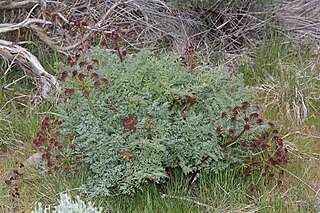
Lomatium dissectum is a species of flowering plant in the carrot family known by the common name fernleaf biscuitroot. It is native to much of western North America, where it grows in varied habitat. It is found in the eastern slopes of the Cascade Range, Rocky Mountains, Klamath Mountains, eastern Transverse Ranges and the Sierra Nevada in California.
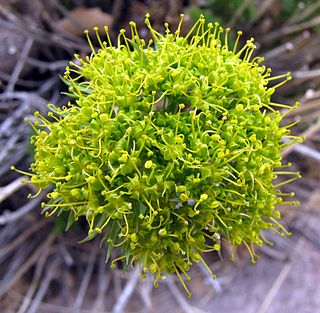
Lomatium parryi, commonly known as Parry's biscuitroot and Utah desertparsley, is a perennial herb in the carrot family. It is a common herb in high altitude areas of deserts and common in desert National parks, such as Death Valley mountains, in the western part of the United States.
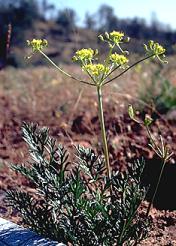
Lomatium congdonii, known by the common names Mariposa desertparsley and Congdon's lomatium, is a species of flowering plant in the carrot family.

Lomatium grayi, commonly known as Gray's biscuitroot, Gray's desert parsley, or pungent desert parsley, is a perennial herb of the family Apiaceae. It is native to Western Canada in British Columbia, and the Western United States, including from the Eastern Cascades and northeastern California to the Rocky Mountains.

Lomatium caruifolium, known by the common name alkali desertparsley, is a species of flowering plant in the carrot family.
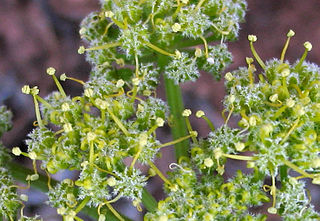
Lomatium dasycarpum is a species of flowering plant in the carrot family known by the common name woollyfruit desertparsley. It is native to California and Baja California, where it is widespread throughout many of the mountain ranges, including the Peninsular, Sierra Nevada, and California Coast Ranges, and in valleys.
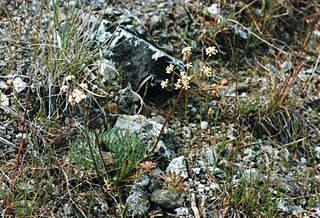
Lomatium engelmannii is an uncommon species of flowering plant in the carrot family known by the common name Engelmann's desertparsley, or Engelmann's lomatium. It is native to the Klamath Mountains of southern Oregon and northern California, where it is a member of the local serpentine soils flora.
Lomatium marginatum is a species of flowering plant in the carrot family known by the common name butte desertparsley. It is endemic to California, where it is known from mountains, valley, and grassland habitat, including serpentine, in the northern half of the state. It is a perennial herb growing up to about half a meter tall from a small taproot. There is no stem, and the leaves and inflorescence emerge from ground level. The purple-green leaves may approach 30 centimeters long, their blades divided into many long, narrow segments. The short but wide inflorescence bears an umbel of yellowish, purplish, or reddish flowers. The Lomatium marginatum is not currently an endangered species.

Lomatium martindalei is a species of flowering plant in the carrot family known by the common names Cascade desertparsley and coast range lomatium. It is native to the west coast of North America, from Vancouver Island south to the Klamath Mountains of far northern California. It can be found in a number of coastal and inland habitats, from coastal plains to high mountain talus and meadows. This is a perennial herb growing 15 to 40 centimeters tall from a carrot-like taproot. There is often no stem, the erect or spreading leaves and inflorescence emerging from ground level. The thinly fleshy leaves may approach 20 centimeters long, their blades divided into leaflets made up of many small oval segments. The inflorescence bears an umbel of small yellowish flowers.

Lomatium mohavense is a species of flowering plant in the carrot family known by the common name Mojave desertparsley. It is native to southern California with a few outlying populations in Arizona, Nevada and Baja California. It is found in several types of mountain and desert habitat, including chaparral, woodland, and scrub, mostly from 2,000–7,000 feet (600–2,100 m) elevation.
Lomatium shevockii is a rare species of flowering plant in the carrot family known by the common name Owens Peak desertparsley, or Owens Peak lomatium. It is endemic to Kern County, California, where it is known from only two occurrences at Owens Peak, one of the highest points of the Sierra Nevada. It is a plant of the talus and wooded slopes of the high mountains. This species was discovered in 1984 and first described to science in 1988.

Lomatium stebbinsii, known by the common name Stebbins' desertparsley, is a rare species of flowering plant in the carrot family.

Lomatium tracyi is a species of flowering plant in the carrot family known by the common name Tracy's desertparsley, or Tracy's lomatium. It is native to the mountains of northern California and southern Oregon, where it grows in the forests on the slopes, often on serpentine soils. It is a perennial herb growing up to 35 centimeters tall from a slender taproot. There is generally no stem, the leaves and inflorescence emerging at ground level. The leaf blades are divided and subdivided into a mass of overlapping threadlike to oval segments. The inflorescence is an umbel of yellow flowers.

Lomatium vaginatum is a species of flowering plant in the carrot family known by the common name broadsheath desertparsley. It is native to northern California and adjacent sections of Oregon and Nevada on the Modoc Plateau. It grows in sagebrush, woodland, and other local habitat. This is a perennial herb growing up to 45 centimeters long from a thick taproot. The leaf blades are divided and subdivided into narrow segments. Leaves higher on the stem are enclosed in sheaths. The inflorescence is an umbel of yellow flowers.

Lomatium observatorium is a rare species of flowering plant in the carrot family known by the common names Mt. Hamilton desertparsley and Mount Hamilton lomatium. It is endemic to California, where it is known only from the mountains of Santa Clara County, including Mount Hamilton near the Lick Observatory. It may also occur in Stanislaus County. Its habitat includes mountain woodlands on volcanic and metamorphosed sedimentary rock substrates. Described The plant to science as a new species in 1996, the plant is a perennial herb growing low to the ground, the lightly hairy herbage growing from a long taproot.
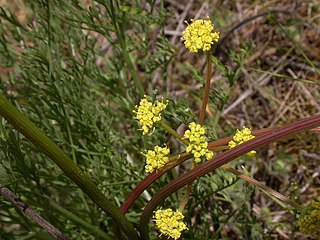
Lomatium cookii is a rare species of flowering plant in the carrot family known by the common names Cook's lomatium and agate desertparsley. It is endemic to Oregon in the United States, where it grows in only two valleys. It is a federally listed endangered species.
Allium dictuon is a species of wild onion known by the common name Blue Mountain onion. It is native to a small section of the Blue Mountains straddling the border between southeastern Washington and northeastern Oregon in the United States. It grows in Columbia, Garfield and Walla Walla Counties in Washington, plus Umatilla and Wallowa Counties in Oregon.
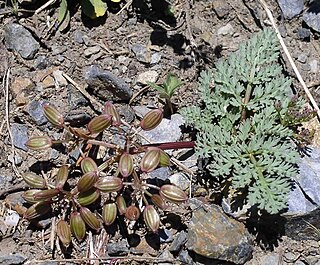
Lomatium erythrocarpum, known by the common name redfruit desertparsley, is a rare species of flowering plant in the carrot family. It is endemic to Oregon in the United States, where it is limited to a section of the Blue Mountains within Baker County.

Lomatium ochocense is a rare species of flowering plant in the carrot family known by the common name Ochoco lomatium. It is endemic to Oregon, where it is limited to the Ochoco Mountains of Crook County.


















